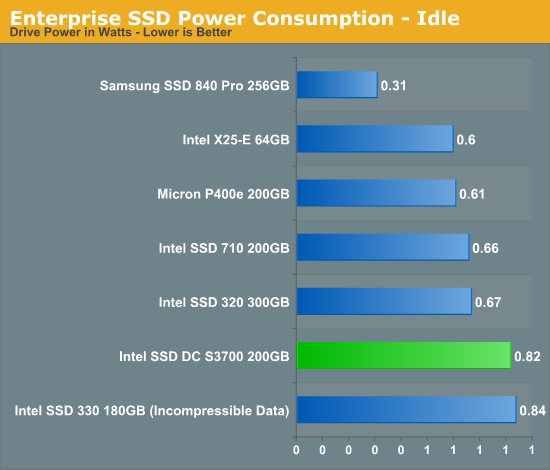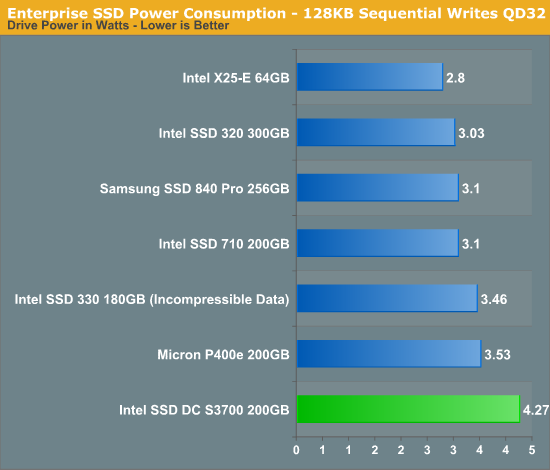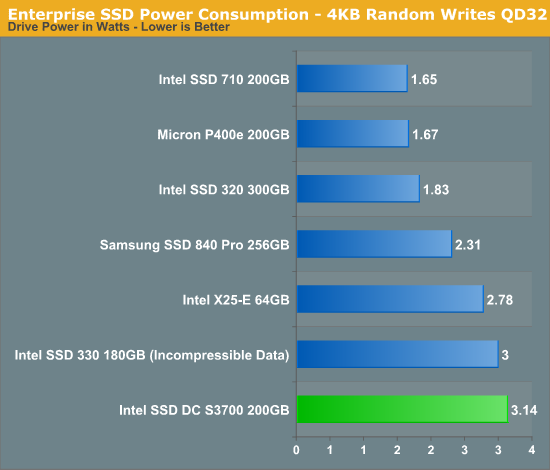The Intel SSD DC S3700 (200GB) Review
by Anand Lal Shimpi on November 9, 2012 8:01 AM EST- Posted in
- Cloud Computing
- Storage
- IT Computing
- SSDs
- Intel
Power Consumption
Intel's SSD DC S3700 can draw power on both 12V or 5V rails. Most 2.5" SATA drives pull from the 5V rail, however the S3700 seems to prefer the 12V if both are attached. The S3700 was the only drive I tested that drew any current on the 12V rail (and none on 5V), everything else was exclusively 5V. If your server supports it, Intel claims the S3700 can pull on both rails simultaneously.
As I alluded to in our S3700 architecture analysis piece, the Intel SSD DC S3700 draws quite a bit of power under load. It's easily the most power hungry Intel enterprise SSD, and it's the worst offender in all but one of our tests. The added power consumption isn't significant enough to be a problem in the datacenter, but it will likely keep the S3700 (or a not-HET derivative) from being a good fit for notebooks. Desktop use is another matter entirely, but Samsung's SSD 840 Pro controller's amazing idle power consumption is a perfect fit for mobile use. I suspect what we're seeing here is the result of Intel's focus on the enterprise market: the S3700 controller was just not built for mainstream mobile client use.













30 Comments
View All Comments
JonnyDough - Thursday, November 15, 2012 - link
There are a ton of new technologies that could replace NAND. There might even be a "betamax" or "HD DVD" in there that miss the mark and lose out to some better or cheaper tech. We'll just have to wait and see what comes to market and catches on. It won't be mere enthusiasts or gamers who decide, it will be the IT industry. It usually is.mckirkus - Tuesday, November 6, 2012 - link
On interesting point to note is that if you run benchmarks on a RAMDisk, you get random 4k write IOPS in the neighborhood of 600MB/s. So in that regard, flash has a long way to go before the 6Gbit/s limitations of SATA 3.0 really hurt enterprise performance.extide - Tuesday, November 6, 2012 - link
I am not sure I understand this. First of all random 4K against a ramdisk will be HIGHLY dependent on the hardware, and I am sure you could see wayy better numbers than 600MB/sec. Also, 600MB/sec is pretty close to 6Gbit/sec, anyways.jwilliams4200 - Friday, November 9, 2012 - link
I think mckirkus is trying to say that there is a lot of headroom before sustained 4KiB random I/O SSD throughput will saturate a SATA 6Gbps link.For example, the sustained QD32 4KiB random write speed for the S3700 is apparently less than 150MB/s (35K IOPS). It will need to double and double again before it saturates a 6Gbps SATA link
mayankleoboy1 - Saturday, November 10, 2012 - link
How long do we have to wait before SATA Express drives and interface get commercial ?justaviking - Saturday, November 10, 2012 - link
If I read this the "Update" section correctly, Oracle recommends modifying their settings to change the way the log files are written.Would it be possible to re-run the the Swingbench tests using the modified settings? I'd love to see how performance changes, especially on THIS drive, and then also on some others for comparison purposes.
blackbrrd - Saturday, November 10, 2012 - link
I am guessing most people will run their Oracle database behind a raid card with some nvram to cache, which would remove the problem if the raid controller combined the writes. It would be interesting to see the performance behind a typical raid controller card with nvram cache.iwod - Sunday, November 11, 2012 - link
I am a regular Anandtech Reader, ( actually it is on my RSS Feeds so i read it everyday ) and i dont ever record Anand doing a Review on Toshiba SSD. So when i saw the performance of the MK4001 i had to look it up in Google to know it is an SAS SLC Enterprise SSD.The article did eventually have a brief mention of its Spec. But i thought it was very late in the article. Would have help it the spec was actually listed out before hand.
It seems to me the Magic is actually in the software and not the hardware. A 1:1 mapping of NAND data Address table making Random Read and Write a consistent behaviour seems more like Software magic and could easily be made on any other SSD Controller with enough amount of RAM in it. The only hardware side of things that requires this tweak is ECC Memory.
And again we are fundamentally limited by Port Speed.
mmrezaie - Monday, November 12, 2012 - link
I agree!alamundo - Monday, November 12, 2012 - link
Given the enterprise focus, this drive seems to be competitive with the Intel 910 PCI card. It would be interesting to see the 3700 benchmarked against the 910.